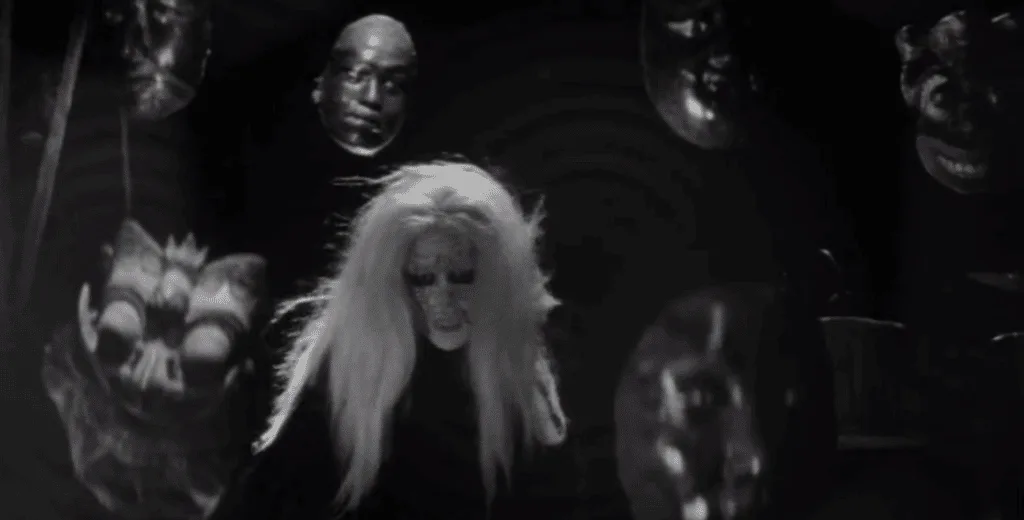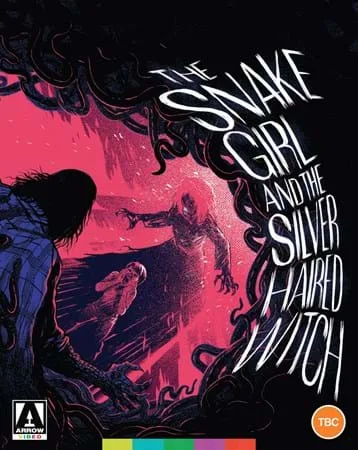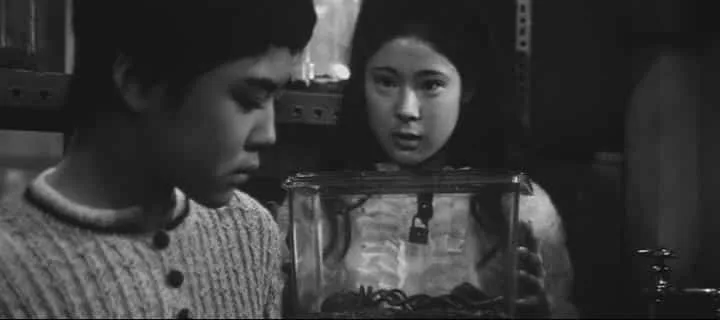
The Snake Girl and the Silver Haired Witch can not be accused of misrepresenting itself with that title; it’s an engaging, fairytale-like film which overlays a warped family dynamic with ‘old dark house’ style horrors, though it never becomes a full-blown horror, balancing its supernatural scares with something far more saccharin. Tonally, it works, and it doesn’t skimp on the snakes or the silver-haired witch, either.
We start as we mean to go on – an unsuspecting maid is scared to death by having a snake hurled at her in the Nanjo household (this isn’t as unlikely as it sounds, as Mr Nanjo is a venomous snake expert and has tanks of them in the house). Into all of this, a child is about to arrive: Sayuri (Yachie Matsui) has been raised in a children’s home, but it’s recently been discovered that she isn’t an orphan after all, and she is in fact the daughter of Mr and Mrs Nanjo. So, she’s packed up and shipped off there, with a warning ringing in her ears that Mrs Nanjo has recently had an accident which has affected her memory. Sayuri is clearly being pitched as the World’s Most Pleasant Child, though, so she obligingly tells her newfound father that there’s nothing to worry about, and she will make the best of it. She bids a farewell to the nuns, and to big brother figure Hayashi (Shin Godzilla’s Sei Hiraizumi).
They weren’t kidding about her mother being a little confused; when she greets Sayuri, she calls her ‘Tamami’, and has trouble recognising her daughter. The fact that Mr Nanjo is soon thereafter called away to Africa to study a rare venomous snake seems to trouble her, too. He’s not gone long when Sayuri notices someone seems to be hidden in the house; no one will believe her when she explains what she’s seen, but she sees Mrs Nanjo leaving food for someone at night, and sees a strange, hybrid-looking girl in her bedroom. It’s explained to her that this is Tamami – her secret older sister, who will now be staying with Sayuri – well, until father gets back, that is. Tamami isn’t too keen on having competition for affection in the house, and soon takes to doing the usual, sisterly things, like threatening to dissolve Sayuri in acid, displacing her from her room and forcing her to live in the attic, dismembering her toys and so on. As the situation escalates, Tamami’s disturbing background is explored further, and this is just the beginning of the ordeal for Sayuri…

Like so many Japanese films, The Snake Girl and the Silver Haired Witch is based on a popular shoujo manga, which more or less guarantees that the film will stick very closely to Sayuri’s personal perspective given that these manga chiefly concern themselves with young female protagonists. In fact, the film frequently uses Sayuri as a narrator, as she mentally unpacks what is going on around her: this is also done with Tamami, though only very briefly. It all feels very storybook in the way it is done; the plot gives us the lonely orphan/stranger in a new household, things which go bump in the dark. a mysterious house, apparently secret rooms and locked doors and a child who must navigate all of the secrets and plots which threaten her. It feels a little like The Reptile via Enid Blyton in some respects, with a lot of the slightly earlier film’s menacing atmosphere though – given there’s a child star in the lead role – the film is mainly atmospheric and suggestive, rather than genuinely frightening, graphic or bloody (with the exception of one scene towards the end of the film, which really is an unsettling moment of peril). Sayuri plays this throughout with wide-eyed innocence, and Tamami is an excellent foil to her character; Mayumi Takahashi has a genuinely eerie presence and looks the part, as well as very plausibly enacting being a nadsty piece of work; Sayuri is sickly sweet, but it’s hard not to empathise with her as she gets put through the mill by her domineering, snake-obsessed sister.
The Snake Girl and the Silver Haired Witch does an excellent job of showing us what’s going on being refracted through an impressionable child’s point of view, and it becomes steadily more clear that a lot of the phenomena Sayuri witnesses is embellished by her imagination: this allows the film to plump for some nicely experimental special effects. Some of these place the film squarely in the late 60s, which is no bad thing – a dream sequence wouldn’t be a dream sequence without a swirling spiral and a theremin, after all – but others are very innovative, and have held up very well. And as for the plot, well, by the hour mark you may have begun to guess at what is going on here, but it’s all nicely-paced and looks gorgeous on screen, doing plenty to reward the interest. It even carries a hint of the modernising Japan of the 60s around the edges, with the lowering high-rise which is being built nearby finding its way into the action.
For fans of the likes of Hausu, there is plenty to love in The Snake Girl and the Silver Haired Witch. It’s an attractive film (looking fabulous on the transfer here) and an atmospheric little time capsule in its own right.
The Snake Girl and the Silver Haired Witch (1968) is available now via Arrow Films. For more information, please click here.
